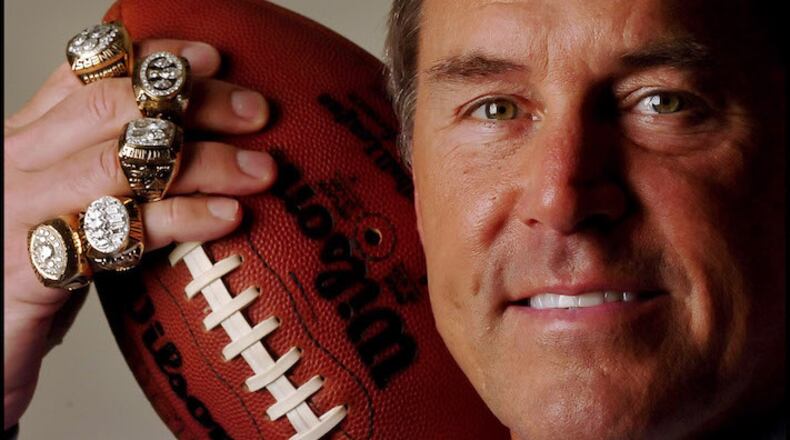The high incidence of amyotrophic lateral sclerosis among the professional football community has led researchers to explore links to the game. In 2012, federal researchers had established that retired pro football players were four times more likely to die from ALS than the general U.S. population, which has five cases per 100,000 people.
The report relied on data from 3,439 ex-players who had been in the NFL at least five seasons from 1959 to 1988. Using death certificates as their basis, researchers also discovered the players had triple the risk of death from brain diseases compared to other people.
Clark suspected football caused his condition. In a March 19, 2017 letter announcing his situation, the popular receiver who is known for "The Catch" urged NFL and players union officials "to continue working together in their efforts to make the game of football safer, especially as it relates to head trauma."
But ALS remains one of the most complex puzzles for medical researchers. Scientists have yet to find a cause for a disease that first gained national attention 78 years ago through New York Yankees' star Lou Gehrig.
"We know that a protein that gets released during stress, concussions and neurological damage is implicated as a cause for ALS as well as other neurodegenerative diseases," Fred Fisher, president and CEO of the ALS Association's Golden West Chapter, told this news organization last year. "But there are people just like you and me who end up getting the disease for no apparent reason."
In late 2016, physicians at the Boston University Brain CTE Center announced they had found an ALS connection with the brain disease chronic traumatic encephalopathy, which only can be diagnosed in cadavers.
Ann McKee, the center's director, also said at the time that 17 brain autopsies performed on football and soccer player thought to have died of ALS showed signs of CTE.
The research is far from conclusive, leading families of athletes struggling with ALS to continue to push for concrete answers.
"I pray for a cure and no more heartache and suffering for those that have been touched by this horrific disease," Chie Smith, the wife of former Raiders fullback Steve Smith, posted on Facebook on Monday.
Steve Smith, 53, is one of the 13 known former NFL players to suffer from ALS.
Here is a list of those players, starting with the ones who have died:
Gary Lewis, a running back on the 49ers' 1964 team. He died in December 1986 in Daly City at age 44. Lewis, who grew up in San Francisco, learned he had ALS only three weeks before dying, according to reports at the time.
Matt Hazeltine, a linebacker from Cal who also played on the '64 team. He died a month and a day after Lewis at age 53.
Bob Waters, a backup quarterback on the 1964 Niners, died in 1989 at age 50. He was a beloved coach at Western Carolina for two decades publicly spotlighting ALS while remaining on the sideline.
Mickey Marvin, a guard with the Raiders from 1977-87 who played on two Super Bowl-winning teams. He died at age 61 two weeks before Clark announced he also suffered from ALS.
Kevin Turner, a fullback for New England and Philadelphia from 1992-99 died in 2016 at age 46. Turner had suffered from severe CTE that caused ALS, according to Boston physicians. In 2013, Turner told CNN, "I really believe that had I not played all those years, that I wouldn't have this condition."
Orlando Thomas, a Minnesota Vikings safety from 1995-2001, died in 2014 at age 42. He was diagnosed with the condition in 2007.
Glenn Montgomery, a Houston and Seattle defensive tackle from 1989-96, died in 1998 at age 31 a year after getting diagnosed.
Steve Gleason, a New Orleans safety from 2000-06, announced in 2011 that he has ALS. At 41, he is the star of "Gleason," a film chronicling his life with the disease.
Steve Smith, a Raiders fullback from 1987-93, has lived with ALS since 2002 Smith, 53, breathes with a ventilator and eats with the help of a feeding tube.
Tim Shaw, an NFL linebacker from 2007-2012 announced two years after retiring that he has ALS. Shaw, 34, once said, "I joke with people sometimes when they say, 'What are you pursuing right now?' I tell them, 'Today, I'm just living not to fall over.' It's a joke, but not really."
O.J. Brigance, an NFL linebacker from 1994-2002 was diagnosed with the disease in 2007. He's 48.
William White, a Detroit, Kansas City and Atlanta safety from 1988-98, learned he had ALS in 2016. He's 53.
About the Author
